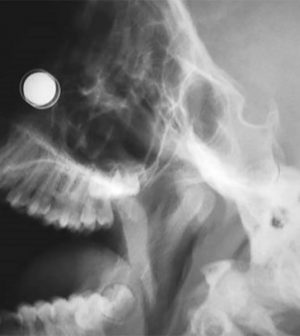- Navigating Your Midlife Crisis: Embracing New Possibilities
- City Raccoons Showing Signs of Domestication
- Mapping the Exposome: Science Broadens Focus to Environmental Disease Triggers
- One Week Less on Social Media Linked to Better Mental Health
- Your Brain Changes in Stages as You Age, Study Finds
- Some Suicide Victims Show No Typical Warning Signs, Study Finds
- ByHeart Formula Faces Lawsuits After Babies Sickened With Botulism
- Switch to Vegan Diet Could Cut Your Greenhouse Gas Emissions in Half
- Regular Bedtime Does Wonders for Blood Pressure
- Dining Alone Could Mean Worse Nutrition for Seniors
Feds Tighten Safety Standards on Tiny High-Powered Magnets That Have Injured Kids

New federal safety standards announced Wednesday aim to keep kids and teens safe from serious or life-threatening injuries from accidental swallowing of high-powered magnets.
The new standards require that certain products with loose or separable magnets contain only those that are weak or too large to swallow.
The aim is to reduce injuries that can occur when swallowed magnets attract to each other inside the body. The risks include perforations, twisting and/or blockage of the intestines, infection, blood poisoning and even death.
Under the new standards, magnets that fit in a small parts cylinder must have a flux index of less than 50 kG2 mm2. Flux index is a measure of magnetic strength.
The U.S. Consumer Product Safety Commission (CPSC) voted Wednesday to approve the new standards.
They apply to consumer products designed, marketed or intended to be used for entertainment, jewelry, mental stimulation and stress relief that contain one or more loose or separable magnets.
The rule does not apply to products sold and/or distributed solely to educators, researchers, professionals and/or commercial users exclusively for educational, research, professional, commercial and/or industrial purposes. It also doesn’t apply to toys for kids under age 14 because the CPSC already has a mandatory toy standard for those.
The change goes into effect 30 days after it is published in the Federal Register. It will affect products manufactured after that date.
Emergency departments treated an estimated 26,600 cases of magnet ingestion between 2010 and last year, with cases rising each year since 2018, according to the CPSC. Seven deaths involving ingestion of hazardous magnets have occurred — two outside the United States. Most probably involved magnet sets, according to the CPSC.
Injuries can occur when kids ingest magnets, for example to mimic mouth piercings.
In 2014, the CPSC established a mandatory federal standard for magnet sets. An appeals court overturned that standard two years later and magnet ingestions and injuries rose after that, according to the CPSC.
More information
The American Academy of Pediatrics has more on children and magnet safety.
SOURCE: U.S. Consumer Product Safety Commission, news release, Sept. 7, 2022
Source: HealthDay
Copyright © 2025 HealthDay. All rights reserved.










